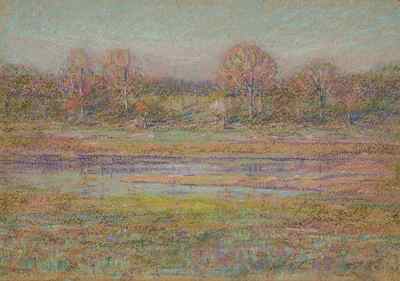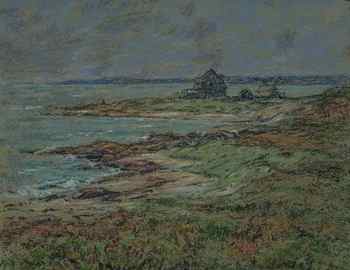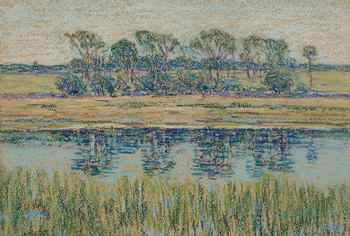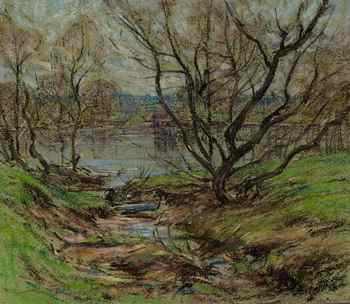The Florence Griswold Museum, the Home of American Impressionism, in Old Lyme, Connecticut, announces its spring exhibition, Visions of Mood: Henry C. White Pastels, on view April 18 through July 12, 2009. Lyme Art Colony painter Henry C. White (1861 – 1952) is the patriarch of a family of Connecticut artists and art patrons. Last year, in some of White’s stored belongings, his grandsons discovered a trove of pastels that had never been on public view. While his oil paintings of his native Connecticut landscape and shore are widely admired by collectors and museums, his accomplishments in pastel are less well known. These vibrant landscapes, breathtaking in their variety, intensity of color, and, at times, abstract boldness, provide insight into a new side of White’s art-making, in which he experimented with color and texture while working out-of-doors. (right: Henry C. White, Spring Vista with Pond, Pastel on buff paper, 9 3/4 x 14 inches. White Family Collection)
Henry Cooke White grew up in Hartford, then a burgeoning metropolis still edged with open fields. Like the boy heroes written about by fellow Hartford resident Mark Twain, White recalled that as a child, he “roamed at will about the city and its outskirts,” hopping aboard railroad trains, making his way to the nearby Connecticut River to fish, or exploring the meadows with his friends. He developed an interest in drawing at an early age and often took sketching materials on these expeditions. After graduating from Hartford Public High School, friend and mentor artist Dwight W. Tryon urged him to go to New York. He took classes with Kenyon Cox, William Merritt Chase, and John Henry Twachtman at the Art Students League, but it was in Tryon’s studio that he flourished. White credited the Tonalist landscape painter with providing him a strong foundation in the principles of art and instilling in him a respect for proportion and harmony. Tryon and White enjoyed a mutual interest in pastels, which they began using around 1890. While Tryon preferred a warm grayish brown paper whose color acted as a halftone or harmonious undertone, White experimented with a broader palette of papers that included oranges, greens, and blues in addition to more neutral shades. Both used primarily wove papers with rough fibers that bit into the pastel crayon, adding an element of texture to their drawings.
Upon his return from New York, White became an art teacher at Hartford Public High School and married his childhood sweetheart Grace Holbrook in 1889. He lamented the difficulty of transforming local scenes into what he called the “paysage intime,” a nineteenth-century term used to describe Barbizon school landscapes that offer viewers both a sense of immersion in nature and a dimension of poetic feeling. In search of a landscape that would inspire such emotion in him, White struck out for the Connecticut shore. Arriving in Waterford, with its sweeping views of the Sound, White felt he found his “Promised Land,” a destination “perfectly adapted to all my needs, physical as well as spiritual and aesthetic.” He bought land on a picturesque point in Waterford for a summer home that he and his family came to occupy year-round.
White’s dedication to the poetic sensibility of the paysage intime is critical to understanding his fascination with pastel. The medium’s subtlety and capacity to suggest a range of moods allowed him to hint at something more profound than mere observation of nature. In White’s finest work, one critic noted, “there is a mysticism, a haunting poetic quality that stirs the senses like a Poe story or an Ibsen play.” Artist James McNeill Whistler’s landmark work in pastel also encouraged White to create dreamy landscapes with his colored pencils.
In later life, the independently minded White dismissed Impressionism as “dots and dashes” and resisted any identification with the movement. Many of his pastels, however, evidence a strong Impressionist strain. White’s seascapes, with their reductive, nearly abstract compositions and broad bands of pigment, earned praise as examples of the so-called “poster effect,” a disposition toward flatness and bold design that the Impressionists picked up from Japanese woodblock prints. His attempt to capture nature’s shifting moods in en plein air sketches corresponds closely with Impressionist aims.
White’s embrace of Impressionist color comes as something of a surprise from an artist who usually preferred the gentle, refined tints of spring and fall to what he called the “spinach” greens of summer. White carefully orchestrated exhibitions of his pastels to foster appreciation of their luminous tones; for a display of his work at the Wadsworth Atheneum’s Annex Gallery in 1914, he hung the warm brown walls with gauzy white cheesecloth to create a more sympathetic backdrop.
White described his house in Waterford as a place of happy solitude, but between 1903 and 1907, he and his family bracketed their summers there with spring and autumn stays in the more sociable environs of the art colony based at Florence Griswold’s boardinghouse in Old Lyme. White’s place in this community of artists is immortalized in Henry Rankin Poore’s The Fox Chase, a humorous group portrait of the main colony participants in which he appears at the wheel of his automobile-a novelty among the artists.
In the catalogue for his father’s memorial exhibition in 1954, Nelson C. White recalled that his father was never happier than when he could “drop everything to be out of doors sketching in pencil or pastel.” The rediscovery of these pastels and their introduction to the public through this exhibition helps reposition White with respect to Impressionism — a feat not possible through his paintings alone. The pastels also reinforce White’s independence. Although an admirer of Dwight Tryon, to whom he has been compared extensively, White clearly pursued his own aesthetic aims, using pastel to experiment with expressive gestures and vibrant colors. This exhibition offers a new side of Henry White-allowing a more nuanced appreciation of this American artist.
A companion exhibition, The Artistic Circle of Henry C. White, features a selection of paintings by White and the artists he befriended and provides a context for understanding his pastels in light of both Tonalism and Impressionism. Although sometimes thought to have been at odds, these two movements exhibit surprising points of intersection in the work of White and his contemporaries. Please click here to view a wall panel from The Artistic Circle of Henry C. White and click here to view the checklist for the exhibition
Catalogue
Accompanying the exhibition is a short, 32-page catalogue featuring a remembrance by the artist’s grandson, painter Nelson H. White, an essay by the curator, and a portfolio of 21 color illustrations. It is available through the Museum’s Shop.
Please click here to view the foreword from the exhibition catalogue.
Please click here to view the exhibition catalogue essay by Amy Kurtz Lansing.
Please click here to view a remembrance by the artist’s grandson, painter Nelson H. White from the exhibition catalogue.
Exhibition Information

Florence Griswold Museum
Visions of Mood: Henry C. White Pastels
April 18-July 12, 2009
More about this exhibition



